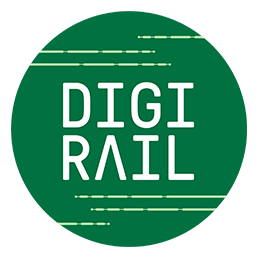The intention in Digirail’s EKA track section is to use a radio network solution to communicate with trains by utilising commercial network connections. One part of this radio network project is a monitoring function that examines how traffic controllers will receive information about service interruptions and disruptions in the future in order to ensure the safe operation of trains.
Digirail aims to use existing commercial network connections to communicate with trains. However, the regulations issued by the International Union of Railways (UIC) do not yet cover the equipment required for the solution, and the new regulations will not be available in time for the implementation of the first commercial track section (EKA). Digirail has therefore developed a brand new temporary radio network solution, called National Radio Solution 1, that utilises existing equipment to enable radio communication via commercial networks. An exemption application for use of the equipment has been made to the European Union Agency for Railways (ERA).
For the radio network project, Digirail has set up four sub-projects associated with the radio network solution. One of them is for technology that is currently the most topical of the sub-projects. The technology sub-project will work to define, among other things, the components and interfaces for the technical solution that will eventually be used. The technology project will create the entire NRS 1 architecture and associated requirements. The architecture on the technological side will therefore also have an impact on what is needed for the exemption process and the approval process, which are two other sub-projects in NRS 1.
“The technological aspects are practically in the completion stage. The NRS 1 architecture has been circulated for commenting, and the purpose is to approve the architecture at the next R&D panel in March. This enables the railway companies that are planning to operate on the EKA track to start their procurement. That is why it is extremely important to get the paper approved and moving forward,” says Project Manager Simon Indola.
Large issues to resolve
The fourth sub-project related to NRS 1 is the Control Room PoC (Proof of Concept), which was kicked-off in the Digirail project in January. The monitoring function will plan how radio network monitoring will be implemented in practice: Who will be doing the monitoring and how? What information do commercial telecommunications companies have about the disruptions and what the procedures will be in case of service interruptions? In practice, the task is to negotiate with three commercial telecommunications companies on the terms with which their networks could be used and the kind of information that they are able to disclose.
Information about disruptions and service interruptions is vitally important for traffic controllers to know whether it is safe to dispatch a train on a particular track section. Radio network connections will have a completely new solution on which there is no previous experience.
“We’re doing something completely unique. For the monitoring function, there are still important questions for which no one can provide a direct answer,” says Indola.
The first meeting between the system integrator and the commercial telecommunications company has already taken place. A meeting with another telecommunications company will be held in a few weeks.
“The meeting provided a good atmosphere for important discussions. The parties shared a common understanding, so the promotion of the project has had a good start in that regard. We’re going to try to see if we can build a system where the data can be put into the desired format and displayed on a view, such as a map view,” says Ville Hämäläinen, radio network and telecommunications specialist at Fintraffic who is the project lead for the Control Room PoC.
A permanent solution for the future
The intention is to gather all the necessary information by October in order to enter the implementation phase and to make the decisions on the type of the monitoring function, the place where it would be located, as well as how and by whom the radio networks would be monitored.
“By then we will know if we need a system that monitors and produces data or whether we will manage things in another way. So, in October, we will be ready to make decisions. If we continue on this system path, we also need to tender the building of the actual system,” Hämäläinen says.
Although the NRS 1 is a temporary solution designed and intended only for the EKA track, the monitoring function will be a permanent solution. In addition to the EKA track, the same monitoring function will also serve the TOKA track and all other track sections, both during the course of the project and after it.
